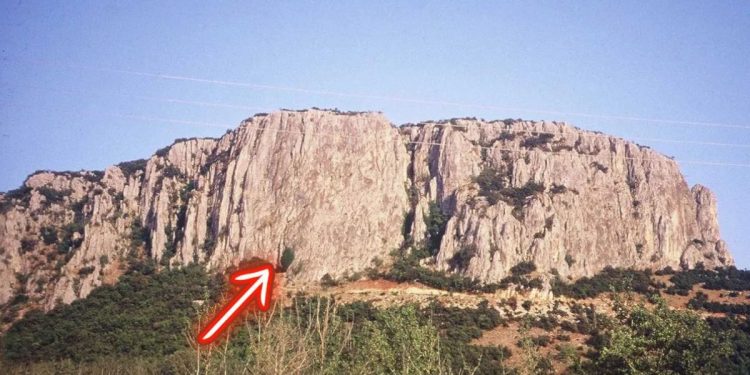Deep within the limestone cliffs of Thessaly, Greece, archaeologists have discovered evidence that rewrites our understanding of the history of human construction. Theopetra Cave, nestled just three kilometers from the famous Meteora Monasteries, is home to what researchers believe to be the oldest artificial structure known to mankind – a stone wall dating back around 23,000 years, making it almost three times older than the Great Pyramid of Khufu in Egypt.
Archaeological wonder hidden in plain sight for millennia
The Theopetra cave system was formed in the Cretaceous period, between 137 and 65 million years ago. However, human occupation began much later, around 130,000 years ago, during the Middle Paleolithic. Neanderthal populations They probably first settled in these protective limestone chambers, marking the beginning of an extraordinary timeline of continuous habitation.
Dr Catherine Kyparissi-Apostolika began systematic excavations in 1987, revealing layers of human activity stretching from the Paleolithic to the Neolithic to around 3,000 BCE. The archaeological team discovered an impressive range of artifacts, including stone tools, shell jewelry, fire traces, burial sites and remarkably preserved children’s footprints. These discoveries demonstrate the crucial role of the cave as a prehistoric sanctuary for successive human populations.
The site’s geological formations have provided exceptional preservation conditions, allowing researchers to study continued human adaptation across multiple climatic periods. Modern scientists continue to make groundbreaking discoveries in various locations, just like recent discoveries where, more than 1,500 feet beneath the ice of Antarctica, scientists made an astonishing discovery, proving that extreme environments often preserve remarkable evidence of life.
Engineering genius during the last ice age
The ancient wall represents a revolutionary architectural achievement built around 21,000 BCE during one of Earth’s harshest climatic periods. Built from carefully selected stones bonded in clay mortar, this structure blocked two-thirds of the entrance to the cave, reducing the opening to approximately one meter in width.
Archaeological analysis suggests that this construction served as critical climate protection against the extreme cold which characterized the last glacial maximum. The wall’s strategic positioning demonstrates a sophisticated understanding of thermal dynamics and airflow control, marking a pivotal moment in human architectural evolution.
| Old structure | Location | Date of construction | Main function |
|---|---|---|---|
| Wall of Theopetra | Greece | 21,000 BCE | Climate protection |
| Catal Höyük | Türkiye | 7,400 BCE | Urban settlement |
| Barnenez Cairn | France | 4,800 BCE | Funerary monument |
| Stonehenge | England | 3000 BCE | Ceremony site |
The engineering techniques used reveal remarkable problem-solving abilities among prehistoric populations. These ancient builders understood material properties, structural stability, and adaptation to the environment long before formal architectural principles emerged. Their innovative approach to survival architecture influenced subsequent construction methods throughout human history.
A treasure trove of prehistoric human evolution
The archaeological layers of Theopetra provide unprecedented information on periods of human transition through prehistoric eras. Successive occupation levels contain tools from the Paleolithic, Mesolithic and Neolithic periods, as well as bone tools, shell artefacts and ancient pottery fragments. The site serves as a complete site prehistoric timeline document human technological progress.
Burial finds dating from 15,000 to 7,000 years ago reveal sophisticated burial practices among small human groups. Archaeological evidence indicates that these inhabitants maintained diverse diets, including wheat, barley, olives, and various sources of meat, suggesting agricultural knowledge and advanced hunting techniques.
Research indicates that cave occupation experienced periodic interruptions corresponding to major climate changes throughout prehistory. During periods of intense cold, residents adapted their living strategies, with the construction of walls representing their most significant architectural response. Later periods saw the cave used as wartime shelter and livestock enclosures, demonstrating its enduring importance to local people.
Just as ancient civilizations demonstrated remarkable foresight, modern scientific predictions continue to shape our understanding of human development. Interestingly, thirty years ago, Stephen Hawking made predictions for 2025 that demonstrated humanity’s continuing capacity for long-term thinking and innovation.
The legacy of humanity’s first architects
Contemporary preservation efforts have closed Theopetra Cave to the public, protecting this fragile archaeological treasure for future generations. Ongoing excavations continue to reveal new information about early European populations, their burial customs, dietary practices and technological innovations. The site remains actively sought by international archaeological teams.
The Theopetra Wall predates famous monuments like the pyramids of Egypt and Stonehenge in England by thousands of years, fundamentally challenging traditional narratives about human architectural capabilities. This discovery demonstrates that human ingenuity manifested long before the emergence of recognized ancient civilizations.
Modern archaeological discoveries continue to expand our understanding of ancient human achievements. Recent discoveries include significant resource discoveries, such as cases where geologists discovered the largest deposit of gold, silver and copper, reminding us that the Earth continues to yield secrets about human history and natural resources.
The Theopetra Cave wall is a testament to man’s adaptability, creativity and instinct for survival during Earth’s most difficult prehistoric times. This A 23,000 year old construction represents not only the oldest building known to humanity, but also evidence of our species’ enduring ability to modify environments for survival and prosperity.









